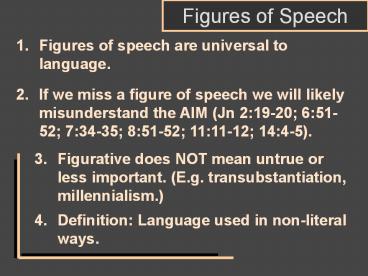Figures of Speech - PowerPoint PPT Presentation
1 / 14
Title:
Figures of Speech
Description:
Figures of Speech ... 1. It attracts attention and is more forceful. ... Simile, metaphor, metonymy, hyperbole, paronomasia. Passage. Parable, allegory, fable ... – PowerPoint PPT presentation
Number of Views:258
Avg rating:3.0/5.0
Title: Figures of Speech
1
Figures of Speech
1. Figures of speech are universal to language.
2. If we miss a figure of speech we will likely
misunderstand the AIM (Jn 219-20 651-52
734-35 851-52 1111-12 144-5).
3. Figurative does NOT mean untrue or less
important. (E.g. transubstantiation,
millennialism.)
4. Definition Language used in non-literal ways.
2
Figures of Speech
Why use it?
1. It attracts attention and is more forceful.
2. It is more memorable and encourages reflection.
3. Because it is more picturesque, it is better
for illustrations.
4. It can make the complex simpler (and
visa-versa) through abbreviation.
3
Figures of Speech
Imagery in Context
Book, Letter
Passage
Sentences or Verses
Words or Verses Type Symbol Emblem Analogy
figures of thought
Simile, metaphor, metonymy, hyperbole, paronomasia
Parable, allegory, fable
Literary Patterns
4
Figures of Speech
Interpretation
1. It should be considered literal unless there
is a valid reason to take it figuratively.
2. Would the literal meaning cause an absurdity
or an inconsistency?
3. Would the literal meaning contradict other
Scripture?
4. Would it cause an immorality (cf. Mt 188-9
Jn 653-58). Caution Gen 22!
5
Figures of Speech
Interpretation
5. The author may clearly identify it as a figure
(Jn 737-38)
6. Sometimes there is a qualifying adjective (cf.
Mt 614 Jn 632 1 Pt 24 Eph 617).
7. Poetic or prophetic genre or symbolic
terminology (colors, numbers, images).
8. Use common sense what is the feel of the
passage?
6
Figures of Speech
Contextual Clues
1. The Authors explanation is best and final.
2. Consider the authors intention and the nature
of the subject beyond just the figure itself.
3. Read the literal comments about the non-figure
which is illustrated by the figure.
4. Notice whether the main point of comparison is
identified (cf. 1 Kgs 124).
7
Figures of Speech
Point of Comparison
1. Identify the point(s) of comparison between
the non-figure and the figure.
2. Each point of comparison is used in only on
way. Dont go crazy here.
3. Work out the major points first, then go on to
the minor ones.
4. Distinguish between essential and embellishing
details of the analogy.
8
Figures of Speech
Other Considerations
1. Historical and biographical research will help
greatly since figures are based on the historical
and cultural reality of the author.
2. Figures are often used to explain figures.
3. The natural meaning(s) are most likely.
4. Use parallel passages, but cautiously
figures do not always mean the same thing in
different contexts.
9
Figures of Speech
Types Antitypes
Greek Tupos (15x) Imprint (Jn 2025),
blueprint (Acts 744, Heb 85), example (1 Cor
106 Php 317 1 Thess 17 2 Thess 39 1 Tim
412 Titus 27 1 Pt 53).
Antitype (2x) Baptism, 1 Pt 321 and Tabernacle,
Heb 924.
Most of them revolve around the Christ, the
Cross, and the Christian (see chart).
10
Figures of Speech
Types AntitypesCharacteristics
1. Resemblance one thing to another.
2. Historic Reality not just an analogy.
3. Prefiguring predictive/foreshadowing.
4. Heightening The N.T. thing is bigger.
5. Divine Design not made up by me.
6. Apologetic value because of 5
7. Not interesting and profitable lessons.
11
Figures of Speech
Benefits of Typology
1. Enables us to see Gods design in history.
2. Pulls together the O.T. and N.T. into one
redemptive plan.
3. Apologetic, like prophecy.
4. Creates wonder at God.
5. Creates interest in Bible students.
6. Provides illustrations for sermons.
12
Figures of Speech
Interpreting Types
1. Determine the literal sense of the type.
2. Note the specific point(s) of comparison.
3. Note the specific area(s) of contrast.
4. Note the direct N.T. assertions that verify
the typological correspondence.
5. Use as pictures in preaching.
6. Dont base typology on colors, numbers,
materials or shapes.
7. Avoid dogmatism when the N.T. is unclear.
13
Figures of Speech
Symbol
A sign which suggests meaning rather than stating
it.
1. A type is a real historical entity, a symbol
may not be.
2. Types/Antitypes span both testaments. Symbols
can stand alone in either.
3. Types may have multiple points of connection.
Symbols have but one.
4. Types may have multiple referents (e.g. Lion
1 Pt 58 Rev 55).
14
Figures of Speech
Categories of Symbols
1. Objects blood (Heb 13), Rainbow (Gen 9).
2. Actions Laying on hands, tearing clothes.
3. Ordinances Baptism, Eucharist.
4. Materials Bronze (Rev 15), linens (Rev 198).
5. Numbers 1, 2-3, 3 ½, 7, 10, 12, 144.
6. Colors Purple, white, red.
7. Names, especially when they are changed Eve
(Gen 320), Abram (Gen 175), Peter.































